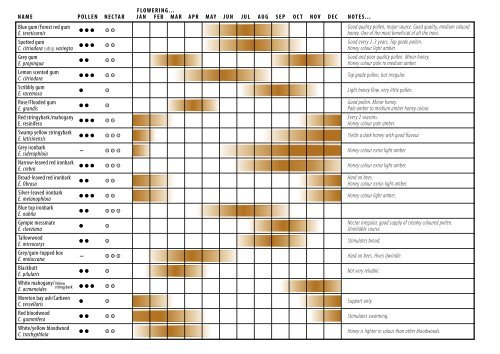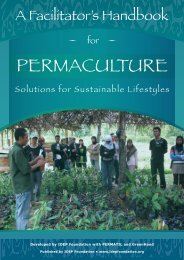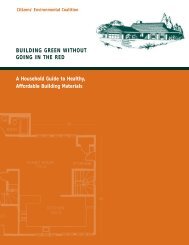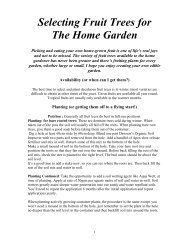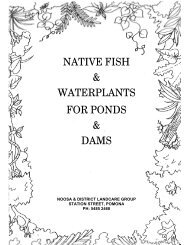Planting Trees to Attract Bees - Green Journey
Planting Trees to Attract Bees - Green Journey
Planting Trees to Attract Bees - Green Journey
You also want an ePaper? Increase the reach of your titles
YUMPU automatically turns print PDFs into web optimized ePapers that Google loves.
F L O W E R I N G . . .<br />
N A M E P O L L E N N E C T A R J A N F E B M A R A P R M A Y J U N J U L A U G S E P O C T N O V D E C N O T E S . . .<br />
Blue gum/Forest red gum<br />
E. tereticornis<br />
Spotted gum<br />
C. citriodora subsp. variegta<br />
Grey gum<br />
E. propinqua<br />
Lemon scented gum<br />
C. citriodora<br />
Scribbly gum<br />
E. racemosa<br />
Rose/Flooded gum<br />
E. grandis<br />
Red stringybark /mahogany<br />
E. resinifera<br />
Swamp yellow stringybark<br />
E. latisinensis<br />
Grey ironbark<br />
E. siderophloia<br />
Narrow-leaved red ironbark<br />
E. crebra<br />
Broad-leaved red ironbark<br />
E. fibrosa<br />
Silver-leaved ironbark<br />
E. melanophloia<br />
Blue <strong>to</strong>p ironbark<br />
E. nubila<br />
Gympie messmate<br />
E. cloeziana<br />
Tallowwood<br />
E. microcorys<br />
Grey/gum-<strong>to</strong>pped box<br />
E. moluccana<br />
Blackbutt<br />
E. pilularis<br />
White mahogany/ Yellow<br />
stringybark<br />
E. acmenoides<br />
More<strong>to</strong>n bay ash/Carbeen<br />
C. tessellaris<br />
Red bloodwood<br />
C. gummifera<br />
White/yellow bloodwood<br />
C. trachyphloia<br />
• • • • •<br />
• • • • •<br />
• • • •<br />
• • • • •<br />
• •<br />
• • •<br />
• • • • •<br />
• • • • • •<br />
- • • •<br />
• • • • • •<br />
• • • •<br />
• • • • •<br />
• • • • •<br />
• •<br />
• • •<br />
- • • •<br />
• • •<br />
• • • • •<br />
• •<br />
• • • •<br />
• • • •<br />
Good quality pollen, major source. Good quality, medium colourd<br />
honey. One of the most beneficial of all the trees.<br />
Good every 2-3 years. Top grade pollen.<br />
Honey colour light amber.<br />
Good and poor quality pollen. Minor honey.<br />
Honey colour pale <strong>to</strong> medium amber.<br />
Top grade pollen, but irregular.<br />
Light honey flow, very little pollen.<br />
Good pollen. Minor honey.<br />
Pale amber <strong>to</strong> medium amber honey colour.<br />
Every 2 seasons.<br />
Honey colour pale amber.<br />
Yields a dark honey with good flavour.<br />
Honey colour extra light amber.<br />
Honey colour extra light amber.<br />
Hard on bees.<br />
Honey colour extra-light amber.<br />
Honey colour light amber.<br />
Nectar irregular, good supply of creamy coloured pollen.<br />
Unreliable source.<br />
Stimulates brood.<br />
Hard on bees. Hives dwindle.<br />
Not very reliable.<br />
Support only.<br />
Stimulates swarming.<br />
Honey is lighter in colour than other bloodwoods.


